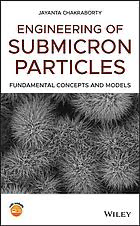
Engineering of submicron particles : fundamental concepts and models PDF
Preview Engineering of submicron particles : fundamental concepts and models
EngineeringofSubmicronParticles Engineering of Submicron Particles FundamentalConceptsandModels JayantaChakraborty DepartmentofChemicalEngineering IndianInstituteofTechnologyKharagpur India Thiseditionfirstpublished2019 ©2019JohnWiley&SonsLtd Allrightsreserved.Nopartofthispublicationmaybereproduced,storedinaretrievalsystem,ortransmitted, inanyformorbyanymeans,electronic,mechanical,photocopying,recordingorotherwise,exceptas permittedbylaw.Adviceonhowtoobtainpermissiontoreusematerialfromthistitleisavailableat http://www.wiley.com/go/permissions. TherightofJayantaChakrabortytobeidentifiedastheauthorofthisworkhasbeenassertedinaccordance withlaw. RegisteredOffices JohnWiley&Sons,Inc.,111RiverStreet,Hoboken,NJ07030,USA JohnWiley&SonsLtd,TheAtrium,SouthernGate,Chichester,WestSussex,PO198SQ,UK EditorialOffice TheAtrium,SouthernGate,Chichester,WestSussex,PO198SQ,UK Fordetailsofourglobaleditorialoffices,customerservices,andmoreinformationabout Wileyproductsvisitusatwww.wiley.com. Wileyalsopublishesitsbooksinavarietyofelectronicformatsandbyprint-on-demand.Somecontentthat appearsinstandardprintversionsofthisbookmaynotbeavailableinotherformats. LimitofLiability/DisclaimerofWarranty Inviewofongoingresearch,equipmentmodifications,changesingovernmentalregulations,andtheconstant flowofinformationrelatingtotheuseofexperimentalreagents,equipment,anddevices,thereaderisurgedto reviewandevaluatetheinformationprovidedinthepackageinsertorinstructionsforeachchemical,pieceof equipment,reagent,ordevicefor,amongotherthings,anychangesintheinstructionsorindicationofusage andforaddedwarningsandprecautions.Whilethepublisherandauthorshaveusedtheirbesteffortsin preparingthiswork,theymakenorepresentationsorwarrantieswithrespecttotheaccuracyorcompleteness ofthecontentsofthisworkandspecificallydisclaimallwarranties,includingwithoutlimitationanyimplied warrantiesofmerchantabilityorfitnessforaparticularpurpose.Nowarrantymaybecreatedorextendedby salesrepresentatives,writtensalesmaterialsorpromotionalstatementsforthiswork.Thefactthatan organization,website,orproductisreferredtointhisworkasacitationand/orpotentialsourceoffurther informationdoesnotmeanthatthepublisherandauthorsendorsetheinformationorservicestheorganization, website,orproductmayprovideorrecommendationsitmaymake.Thisworkissoldwiththeunderstanding thatthepublisherisnotengagedinrenderingprofessionalservices.Theadviceandstrategiescontainedherein maynotbesuitableforyoursituation.Youshouldconsultwithaspecialistwhereappropriate.Further,readers shouldbeawarethatwebsiteslistedinthisworkmayhavechangedordisappearedbetweenwhenthisworkwas writtenandwhenitisread.Neitherthepublishernorauthorsshallbeliableforanylossofprofitoranyother commercialdamages,includingbutnotlimitedtospecial,incidental,consequential,orotherdamages. LibraryofCongressCataloging-in-PublicationData Names:Chakraborty,Jayanta,1976-author. Title:Engineeringofsubmicronparticles:fundamentalconceptsandmodels/ JayantaChakraborty,DepartmentofChemicalEngineering,IndianInstitute ofTechnologyKharagpur,India. Description:Hoboken,NJ,USA:JohnWiley&Sons,Inc.,[2019]|Includes bibliographicalreferencesandindex.| Identifiers:LCCN2019015637(print)|LCCN2019018492(ebook)|ISBN 9781119296454(AdobePDF)|ISBN9781119296782(ePub)|ISBN9781119296461 (hardcover) Subjects:LCSH:Nanoparticles. Classification:LCCTA418.78(ebook)|LCCTA418.78.C4752019(print)| DDC620.1/15–dc23 LCrecordavailableathttps://lccn.loc.gov/2019015637 CoverDesign:Wiley CoverImage:CourtesyofJayantaChakraborty Setin10/12ptWarnockbySPiGlobal,Pondicherry,India 10 9 8 7 6 5 4 3 2 1 Dedicatedtomyparents,whohadthecouragetopushusforhighereducation againstmanyodds. vii Contents Preface xi AbouttheCompanionWebsite xv 1 Nucleation 1 1.1 ThermodynamicsofInterfaces 1 1.1.1 TheInterfaceisaSurfaceofHighEnergy 1 1.1.2 TheInterfaceisaSurfaceUnderTension 3 1.1.3 PressureDropAcrossCurvedInterfaces 3 1.1.3.1 CapillaryRise 6 1.1.4 Vapour–LiquidEquilibriumAcrossCurvedInterfaces 7 1.1.4.1 ThomsonEquation 11 1.1.5 StabilityoftheEquilibrium 12 1.2 HomogeneousNucleation 13 1.2.1 EnergeticsofHomogeneousNucleation 13 1.2.1.1 EnergeticsinTermsofNumberofUnits 16 1.2.2 KineticsofHomogeneousNucleation 17 1.2.2.1 ConcentrationofEmbryos/Nuclei 18 1.2.2.2 ChainofReactionsTowardsFormationofNuclei 19 1.2.2.3 AlgebraicManipulationoftheRateExpression 22 1.2.2.4 VariousFormsofHomogeneousNucleationRate 24 1.2.3 ExperimentalAspectsofHomogeneousNucleation 26 1.2.3.1 InvestigationUsingaCloudChamber 26 1.2.3.2 OtherMethods 27 1.3 Non-HomogeneousNucleation 28 1.3.1 HeterogeneousNucleation 28 1.3.2 NucleatingAgentsandOrganizers 30 1.3.3 SecondaryNucleation 30 1.4 Exercises 31 Bibliography 33 viii Contents 2 Growth 35 2.1 TraditionalCrystalGrowthModels 36 2.1.1 DiffusionControlledGrowth 37 2.1.2 SurfaceNucleationControlledGrowth 38 2.1.2.1 RateofMononuclearGrowth 40 2.1.3 SurfaceDislocationControlledGrowth:BCFTheory 41 2.1.3.1 RateofSurfaceDislocationControlledGrowth 42 2.2 FaceGrowthTheories 44 2.2.1 ShapeofaCrystal 45 2.2.2 LawsofFaceGrowth 47 2.2.2.1 LawofBravaisandFriedel 47 2.2.3 Flat,Stepped,andKinkedFaces 47 2.3 MeasurementofParticleSizeandShape 49 2.3.1 OpticalMicroscopy 50 2.3.2 ElectronMicroscopy 51 2.3.3 LightScattering 51 2.3.3.1 RayleighScattering 52 2.3.3.2 StaticandDynamicLight-ScatteringTechniques 55 2.4 Exercises 55 Bibliography 56 3 Inter-ParticleForces 57 3.1 Inter-MolecularForces 58 3.1.1 Charge–ChargeInteractions 58 3.1.2 Charge–DipoleInteractions 59 3.1.3 Dipole–DipoleInteractions 60 3.1.4 Dipole–InducedDipoleInteractions 61 3.1.5 InducedDipole–InducedDipoleInteractions 62 3.1.6 vanderWaalsInteraction 62 3.1.7 RepulsivePotentialandtheNetInteractionEnergy 63 3.2 Inter-ParticleForces 63 3.2.1 Hamaker’sPairwiseAdditivityApproach 64 3.2.2 Lifshitz’sTheory 67 3.3 MeasurementofInter-MolecularForces 68 3.4 MeasurementofForcesbetweenSurfaces 70 3.5 Exercises 73 Bibliography 73 4 Stability 75 ChargedInterface 75 4.1 ElectrostaticPotentialNearaChargedSurface 76 4.2 SolutionofthePoisson–BoltzmannEquation 77 4.3 RepulsiveForcebetweenTwoSurfaces 80 Contents ix 4.4 StericStabilization 85 4.5 KineticsofStability 86 4.5.1 DiffusionofColloidalParticles 87 4.5.2 ParticleAggregationintheAbsenceofPotential 88 4.5.3 ParticleAggregationinthePresenceofaNetPotential 90 4.6 MeasurementofSurfacePotential 92 4.6.1 SurfacePotentialWhenR <<𝜅−1 93 s 4.6.2 SurfacePotentialWhenR >>𝜅−1 95 s 4.7 Exercises 97 Bibliography 99 5 ElementaryConceptsofNumberBalance 101 5.1 StateofaParticle 102 5.2 StateofaPopulationofParticles 105 5.3 NumberBalanceforaSeededBatchCrystallizer 110 5.3.1 CouplingthePBEwithMassBalance 114 5.3.2 ModificationfortheUnseededCase 115 5.4 NumberBalanceforOpenSystems 115 5.5 Exercises 118 Bibliography 120 6 BreakageandAggregation 121 6.1 BreakageFunctions 121 6.2 NumberBalanceforBreakage 126 6.2.1 DiscreteBreakageEquation 129 6.3 TheProcessofAggregation 129 6.3.1 NumberBalanceforAggregation 131 6.3.2 SimplificationoftheAggregationEquation 133 6.3.3 ModelsforAggregationFrequency 136 6.4 Exercises 138 Bibliography 142 7 SolutionofthePopulationBalanceEquation 143 7.1 OperationsInvolvingMomentsofthePBE 143 7.2 AnalyticalSolutionsofthePBE 146 7.2.1 SolutionoftheGrowthEquation:MethodofCharacteristics 146 7.2.2 SolutionoftheAggregationEquation:MethodofLaplace Transforms 147 7.2.3 SolutionoftheBreakageEquation:SimilaritySolution 148 7.2.3.1 BreakageEquationinTermsofMassFractionUndersize 149 7.2.3.2 SelfSimilarFormoftheBreakageEquation 151 7.3 NumericalSolutionofthePBE 152 7.3.1 DiscretizationUsingFiniteVolume 153 x Contents 7.4 Exercises 155 Bibliography 156 8 KineticMonteCarloSimulation 157 8.1 RandomVariables 157 8.1.1 UniformRandomNumbers 158 8.2 AlgorithmforKMCSimulation 159 8.2.1 SpecificationoftheSystem 160 8.2.2 TimebetweenEvents:IntervalofQuiescence 160 8.2.3 SamplingaDistribution 161 8.2.4 EventsandtheirRegistration 163 8.3 Exercises 166 Bibliography 166 A MathematicalTopics 167 A.1 GeometryofaHeterogeneousDrop 167 A.2 Young’sEquation 168 A.3 ChordTheorem 169 A.4 JacobianofVariableTransformationinaMultipleIntegral 169 A.5 MethodofCharacteristics 171 Bibliography 173 B SolutionofSelectedProblems 175 B.1 GeneralProblemSolvingStrategy 175 B.2 SolutionsofSelectedProblems 176 Bibliography 183 C Codes 185 C.1 Distance-DependantPotential 185 C.2 SolutionofBreakagePBE 186 C.3 SolutionofAggregationPBE 190 C.4 SamplingofaDiscreteDistribution 194 C.5 SamplingofaContinuousDistribution 195 C.6 SimulationofBreakageUsingKMC 196 C.7 SimulationofBrainvitaGame 198 D ExperimentalDemonstration 201 Bibliography 202 Index 203 xi Preface Intheprocessindustry,manyproductsandintermediatesexistintheformof fineparticles.Manynext-generationprocesses,suchascolloidalheattransfer fluidsforelectroniccooling,alsoinvolvesmallparticles.However,theabilityof theprocessindustrytodealwithparticulateprocessesinaquantitativewayis limited.Theprocessindustrymustenhanceitscapabilityintheengineeringof fineparticles. Manyresearchlaboratoriesalsoproduceandhandlesubmicronparticles.In abroadersense,suchparticulatesystemsincludepowders,polymers,colloids orevenhumanpopulations.Whilemanyengineeringtextbooksandreference books deal with particles of micron scale and above, submicron particles are discussed mostly under very specialized subtopics and a reference book dis- cussingthefundamentalconceptsofsuchsystemsismissing. Everyday activities in an industrial or academic research laboratory where particulatesystemsareinvolvedrequireapplicationofanumberofquantita- tiverelationscalledmodels.Evenexperimentalfacilitiesusemodelstorelate therawdatawiththequantityofinterestandoftentheuserisnotawarethat theoutputsareactuallyfromamodel.Mostmodelsarenotstraightforwardand nosingleresourceisavailabletoprovideunderstandingoffrequentlyusedtech- niquesandconcepts.Newresearchersoftenfindthemselvesatalossandtend totrustdatablindly.Thisbookattemptstoresolvethisproblembydiscussing thefundamentaltheoriesbehindmanyfrequentlyencounteredparticulatepro- cesses. A large number of diagrams, software, examples, brief experimental demonstrations,andexerciseswithanswersareincludedandhavebeencare- fullyplannedtoprovidegoodlearning. Particulate systems are used by physicists, chemists, mathematicians, and engineers. It is difficult to provide fundamental knowledge to the degree demanded by all. This book is mainly aimed at senior undergraduate or graduate chemical engineering students but provides enough background materialintheappendicestobealsousefultostudentsfromotherbranchesof scienceandengineering. xii Preface Modelsareusedatvariouslevelsinparticletechnology.Asetofbasicmodels describe the fundamental process of nucleation, growth, and aggregation of particles. In these models, the rate of nucleation of particles from a medium ofgivensupersaturation,therateofincreaseofsizeofaparticleofgivensize underasetofenvironmentalconditions,andtherateofaggregationofgiven pairsareprovided. Classical nucleation theory is discussed at length in this text. Other nucle- ation mechanisms, e.g. the organizer mechanism, are also introduced. For growth, the classical growth models such as diffusion controlled and surface nucleation controlled growth are discussed, along with newer models like connected net analysis. Aggregation models and inter-particle potentials are discussedwithabriefbutusefulpreludeoninter-molecularandsurfaceforces. Thebasicmodelsalonecannotdescribethedynamicsofanengineeringsys- temcontainingalargenumberofparticlesofvaryingattributes.Forthisanum- berbalanceequation(populationbalance)isneeded.Inthisbooktheemphasis isonformulatingthenumberbalanceequation(thepopulationbalancemodel) for a given system. Analytical and numerical solutions of population balance modelsarealsodiscussedbriefly.Softwarewithopencodeisprovidedforthe solutionofapopulationbalancemodelthroughdiscretization. To my knowledge no book serves such a diverse yet unified purpose. This bookhasbeeninmymindthroughoutmycareeroverthepastdecade,during whichImademyjourneyfromanexperimentallaboratorytotwotheoretical laboratoriesandthenbacktoexperiments.Thisbookcontainsusefulinsights whichIacquiredovertime. Thisbookisheavilyindebtedtoseveralbooksandmonographswhichhelped meinassimilatingthecontent.Ikeptclosetotheflowofideasandconceptsof the parent books whenever I felt that was best for the reader. I acknowledge majorcontributionsfromthefollowingbooksandmonographs: • FoundationsofColloidSciencebyR.J.HunterandKineticsofPrecipitation byA.E.Nielsenforthenucleationandgrowthchapters. • Thechapteroninter-molecularandinter-particleforcehasideasandcon- tentsfromIntermolecularandSurfaceForcesbyJacobIsraelachvili. • ThestabilitychapterisheavilyindebtedtoPaulC.Hiementz(Principlesof ColloidandSurfaceChemistry). • TheparticulatesystemmodellingsectionisindebtedtoPopulationBalances byD.RamkrishnaandTheoryofParticulateProcessesbyA.D.Randolphand M.A.Larson. • Muchofthebookisalsoinfluencedbythelecturenotescirculatedduringmy graduatecourseonmodellingattheIndianInstituteofScience,Bangaloreby Prof.K.S.GandhiandProf.SanjeevKumar. Apart from these major resources there are many other books and mono- graphsthathelpedmetounderstand,assimilate,andexpresstheideas.Ialso
